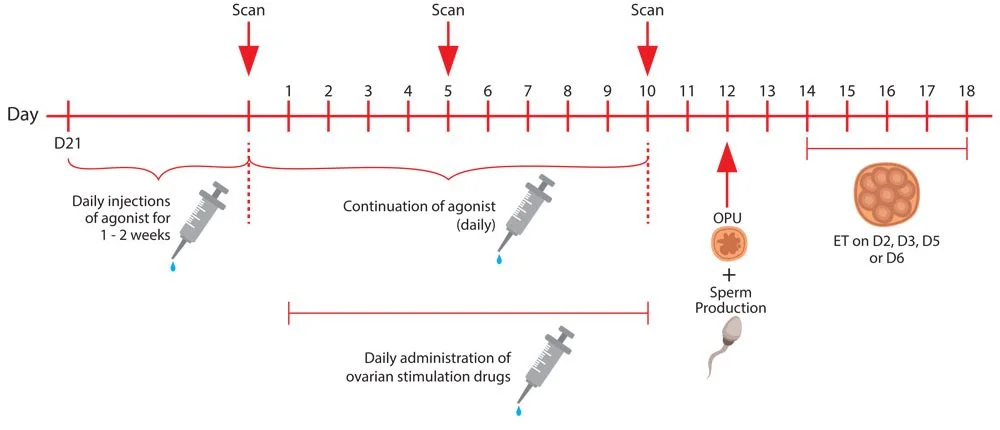In vitro fertilization (IVF) is a complex procedure that involves multiple steps, including ovarian stimulation, egg retrieval, fertilization, embryo culture, and embryo transfer. The specific protocol used for IVF can vary depending on the individual patient’s circumstances and the fertility clinic’s approach. However, there are a few main types of IVF protocols that are commonly used.
1. Long Lupron Downregulation Protocol
The long lupron downregulation protocol is the most traditional and widely used IVF protocol. It involves using the medication lupron to suppress the ovaries for about a month before starting ovarian stimulation. This helps to prevent premature ovulation and ensure that all of the follicles (fluid-filled sacs that contain eggs) are developing synchronously. The long lupron downregulation protocol is considered to be effective for a broad range of patients, especially those with regular menstrual cycles and good ovarian reserve.
2. Antagonist Protocol
The antagonist protocol is a newer alternative to the long lupron downregulation protocol. It involves using a medication called an antagonist to suppress the ovaries instead of lupron. Antagonists are not as effective as lupron at suppressing the ovaries, so the treatment period is typically shorter, about 2-3 weeks. The antagonist protocol is often preferred for patients with a history of ovarian hyperstimulation syndrome (OHSS) or those who may be at risk of OHSS.
3. Short Lupron Flare Protocol
The short lupron flare protocol is a variation of the long lupron downregulation protocol. It involves using a low dose of lupron to start ovarian stimulation, and then adding a higher dose of lupron or agonist to suppress the ovaries later in the cycle. This protocol is thought to be more effective than the antagonist protocol and less risky than the long lupron downregulation protocol. The short lupron flare protocol is often used for patients with a history of poor ovarian response or those who may not respond well to traditional IVF protocols.
4. Mild Stimulation IVF Protocol
The mild stimulation IVF protocol is a less aggressive type of IVF protocol that is often used for women with poor ovarian reserve or older women. It involves using lower doses of fertility medications to stimulate the ovaries, which results in fewer eggs being retrieved. However, the quality of the eggs retrieved is typically higher, which can improve the chances of success.
The mild stimulation IVF protocol is often used for patients who have not responded well to traditional IVF protocols or who are at risk of OHSS. So here we can recommend Alka IVF which has been working for a very long time with great results.
Factors that Influence the Choice of IVF Protocol
The choice of IVF protocol is typically made by the patient’s fertility doctor and is based on several factors, including:
- The patient’s age
- The patient’s ovarian reserve
- The patient’s medical history
- The fertility clinic’s approach
What to Expect During IVF
No matter which IVF protocol is used, the overall process of IVF is typically as follows:
- Ovarian stimulation: The patient takes fertility medications to stimulate the ovaries to produce multiple eggs.
- Egg retrieval: The eggs are retrieved from the ovaries through a procedure called egg retrieval.
- Fertilization: The eggs are fertilized with sperm in the laboratory.
- Embryo culture: The embryos are cultured in the laboratory for a few days.
- Embryo transfer: One or two embryos are transferred to the patient’s uterus.
The success rate of IVF varies depending on the patient’s circumstances, but it is generally around 30-40%.
Conclusion
IVF is a complex procedure with many variables, and the choice of IVF protocol is an important decision. Patients should work closely with their fertility doctor to determine the best protocol for their individual needs.
In addition to the four main IVF protocols mentioned above, there are several other less common protocols that may be used in certain cases. These include:
- Natural cycle IVF: This protocol does not involve ovarian stimulation and is only used for patients who ovulate regularly on their own.
- Duo-stimulation IVF: This protocol involves using two different types of fertility medications to stimulate the ovaries.
- Microdose flare IVF: This protocol is a variation of the short lupron flare protocol that uses even lower doses of lupron.
Ultimately, the best way to determine which IVF protocol is right for you is to consult with your fertility doctor. They can review your medical history, assess your ovarian reserve, and discuss the pros and cons of each protocol to help you make an informed decision.








